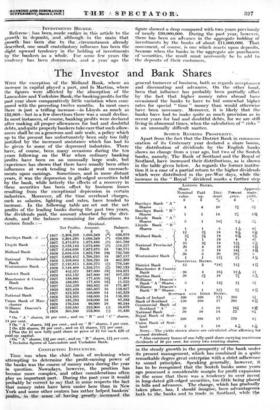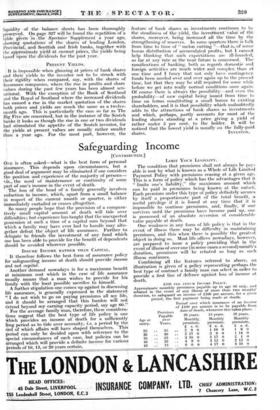The Investor and Bank Shares
-
Wrrn the exception of the Midland Bank, where an increase in capital played a part, and fn Martins, where the figures were affected by the. absorption . of the Lancashire and Yorkshire Bank,-the banking profits for the past year show comparatively little variation when com- pared with the preceding twelve months. In most cases there -is- just a trifling increase-in Lloyds as -much as £52,000-but in a few directions there was a small decline. In most instances, of course, banking profitS were declared after making all proper allowances for bad and doubtful debts, and quite properly bankers take care that such allow- ances shall be on a generous and safe scale, a policy. which up to the present has unfortunately been only too fully justified by the increased assistance which has had to be given to _Soine of the depressed industries. There have, of course, been many occasions during the ten years following on the War when ordinary banking profits have been on an unusually large scale, but experience has shown that there have usually been other influences at work tending to make great encroach- ments upon earnings. Sometimes, and in more distant years, it was the depression in gilt-edged securities held by the bank, while latterly the effects of a recovery in these securities has been offset by business losseS resulting from the ejceeptional ; depression in certain industries. Moreover, all the time overhead charges, such as salaries, lighting. and rates, have tended to increase. In the following table are set out the net profits of the leading banks during the past two years, the dividends paid, the amount absorbed by the divi- dends,. and the ba rem alnceremaining for allocations to various funds :-
Barclays Bank 4e. Lloyds Bank Midland Bank National Provincial Bank Westminster Bank ..
District Bank • • Manchester & County Bank Martins Bank • ' 1 National Bank Union Bank of Man- cheater Williams Deacon's Bank
1927 1928 1927 1928' 1027. 1928 1927 1928 1927 1928 1927 1928 1927 1928 1927 1928 1927 1928 1927 1928 1927 1928
Dividend.
Net Profits. Amount.
£ £ % -2,306,328- 1,666,349 (5) 2,301,28.5 1,666,349 (5) 2,475,674 1,973,886 (f)
2,528,143 1,973,886 2,554650 l',823,875 18 2,656,554 1,923,788 181 2,093,452 1,706,295 18 2,108,664 1,706,295 18
2,132,815 1,356,275 (#1 2,148,408 1,356,275 (#1
452,521 347,600 181 455,132 347,600 181 188,860 177,456. 161 188,681 177,456 161 555,229 383,822 16 825,434 665,607 16 313,329 168,000 14 324,105 168,000 14 195,283 108,000 18 176,544 96,000 16 . 310,585 253,906 (II) 305,340 253,906 (II) * On " A " shares, 10 per cent., and on " B " and " C " shares, 14 per cent.
• 1' On " A " shares, 161 per cent., and on " B " shares, 5 per cent. On £20 shares, 20 per cent., and on £1 shares, 121 per cent: § Plus the £1 new fully-paid share at price of £2 for each £20 of
paid-up capital. 3 On " A " shares; 131 per dent:, and on " B " shares, 121 per cont. If Includes figures of Lancashire and Yorkshire Bank.
CONFLICTING INFLUENCES.
Time was when the chief basis of reckoning when attempting to determine the profit-earning power of the banks was the course of money rates during the year in question. Nowadays, however, the position has become more complex, and other considerations often play an important part. During the past year it would probably be' correct to say that in some respects the fact that money rates have been easier here than in New York and some other centres has rather helped. bankers' fircifitis;. in the sense_ of having greatly increased the
Balance.
639,979 634,936 501,788 554,257 730,775 732,766 387,157 402,369 776,540 792,133 104,921 107,532 11,404 11,225 171,407 159,827 145,329 156,105 87,283 80,544 56,679 51,436
general turnover of business, both as regards acceptances and discounting and advances. On the other hand, been that influence has probably been partially offset by the fact that higher money rates abroad have occasioned the banks to have to bid somewhat higher rates for special " time " money than would otherwise have 'been necessary. Moreover, it is likely that the banks have had to make quite as much provision as in recent years for bad and doubtful debts, for we are still : living in abnormal times, when the calculation of " risks " is an unusually difficult matter.
SCOTCH BANKING PROSPERITY.
Apart from the fact -that the District Bank in comment- oration of its Centenary year declared a share bonus, the distribution of dividends by the English banks 'shows no change from a year ago, but two of the Scotch banks, namely, The Bank of Scotland and the Royal of Scotland, have - increased their distributions, as is shown in the table given below. As regards the former tion it is a case of a partial return to the higher dividends which were distributed in the pre-War days, while die increase in the " Royal " dividend marks a further step
•
Barclays Bank " A " Shares .. Barclays Bank It B
Shares .. Lloyds Bank " A"
Shares .. Lloyds Bank tt -Shares .. 1 5
12 21 18 Midland Bank 21 21 18 Westminster Bank { National Provincial 25 Bank 20 l 1
1 5 5 20
4 18 5 18 31 18
1 121
1 18 .
Balms.
PROVINCIAL
3 *18} District Bank 15 Manchester & County 16% 121. Bank - 20 4 7f 5% Martins Bank .. 20 21 16 5f Williams Deacon's 131 21 5/ Bank " A " Shares . 5 1 Williams Deacon's 121 21 411 Bank B " Shares. - 1 1 BA/Tics.
SCOTTISH AND IRISH
171 306 5% Bank of Ireland .. 100 100 17 381 41/ Bank of Scotland .. 150 100 Commercial Bank of 16 161 4 It Scothuni " A " 20 5 14 22 61 National Bank .. 50 10 Royal Bank of Scot- land 100 100 17 370 Union Bank of Scot-
5 1 18 4, 4i Norx.-The yields shown above are calculated after allowing for accrued dividend.
* Also centenary bonus of one fully-paid share carrying maximum dividends of 10 per cent. for every two existing shares.
in the steady growth in the prosperity of the bank under its present management, which has combined in a quite remarkable degree great enterprise with a strict adherence to sound principles. Speaking generally, however, it has to be recognized that the Scotch banks some years ago possessed a considerable margin for profit expansion in the sense that there was a tendency to over invest in long-dated gilt-edged securities, too little being placed in bills and advances. The change, which has gradually taken place, has, I should. imagine, been advantageous both to the banks and to trade in Scotland, while the
LONDON BANKS. Share.
Nominal Paid Divi- value. up. dend. £ - o/ Present price.
£
4 4 10 71 1 1 14 21 5 1 101 3 h- 1 lir /11 4 12/ 131 181 201
4) .11
3 411 5 41% 111 411
Approxi- mate ;
.
% 51 411 .5% 41 411 41
41
liquidity of the balance sheets has -been- thoroughly pieseryed.. On page 827 will be found the repetition of a table given 'in .the Special& Snpplement a year ago, showing quotations- of the shaies of leading Lendon, Provincial, and Scottish and Irish banks, together with the approximate yield at current prices, the yields being based upon the dividends for the past year.
•
PRESENT YIELDS. •
glancing It is impossible when glancing at prices of bank shares and their yields to the investor not to be struck with their rigidity when compared, lay, with the shares of Insurance companies, where the rise in profits and share values during the past few years has been almost sen- sational. With the -exception of the Bank of Scotland and the Royal of Scotland where the increased dividend's has caused a rise in the market quotation of the shares both prices and yields• are much the same as a twelve- Month ago. This is particularly the case so far as The Big Five are concerned, but in the instance of the Scotch banks it looks_as though the rise in one or two dividends had stimulated the appetite of the Scotch investor, for the yields at present values are usually rather smaller than a year ago. For the most part, however, the feature of bank shares -as investments continues to be the steadiness of yract, the investinent"valui—of the shares, moreover, being increased all the time by the strengthening of reserves. In some quarters 'there is talk from time to time of " melon cutting "—that is, of some bonus distribution of accumulated profits, but I cannot help thinking that such expeCtitions are ill-founded; so far at any-rate as the-neat future is concerned. The ramifications of banking, both as regards domestic and foreign activities are much wider and complex than at one time and I fancy that not only have contingency funds been needed over and over again up to the present time, but that they may be still required for some while before we get into really normal conditions once again: Of course there is always the possibility—and even the probability=-=of new capital being issued from time to time on terms constituting a small bonus to existing shareholders, and it is that possibility which undoubtedly adds to the attractions of bank shares as investments and which, perhaps, partly accounts for most of the leading shares standing at a price giving a yield of rather under 5 per cent, to the holder. It will be noticed that the lowest yield is usually on the fully-paid

























































 Previous page
Previous page